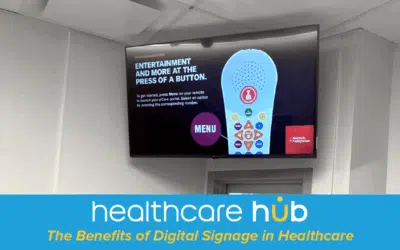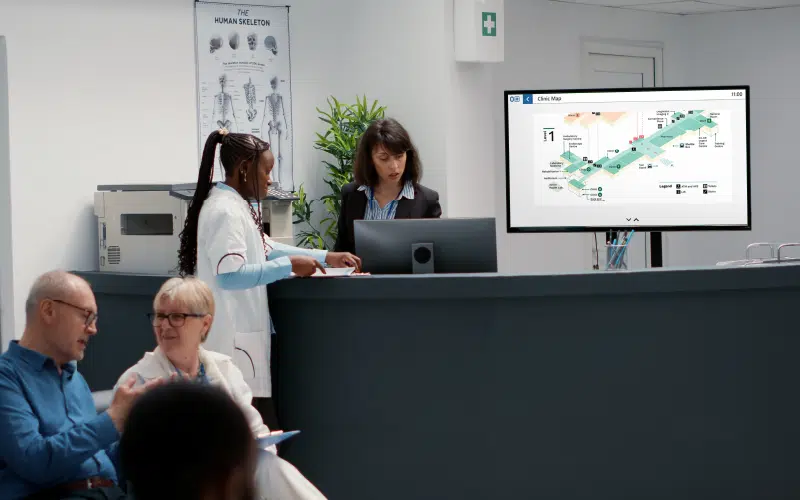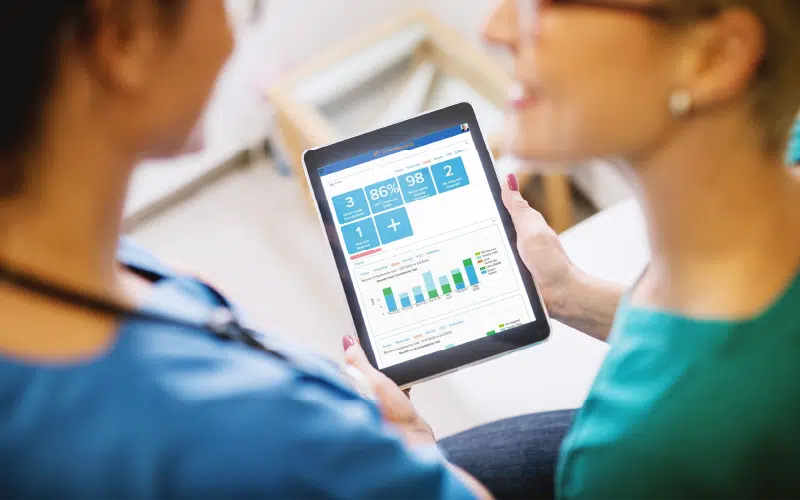 In today’s fast-paced health systems, clarity and agility matter more than ever. Patients and staff alike expect up-to-date, trustworthy information—without delays or confusion. That’s why digital signage in healthcare is no longer optional: it’s foundational infrastructure.
With Uniguest Healthcare Hub organizations gain a unified, cloud-first solution for delivering dynamic content across digital signage, interactive TV, room signage, wayfinding, and more.
Below, we explore how healthcare digital signage elevates patient experience, improves operations, and supports institutional goals.
In today’s fast-paced health systems, clarity and agility matter more than ever. Patients and staff alike expect up-to-date, trustworthy information—without delays or confusion. That’s why digital signage in healthcare is no longer optional: it’s foundational infrastructure.
With Uniguest Healthcare Hub organizations gain a unified, cloud-first solution for delivering dynamic content across digital signage, interactive TV, room signage, wayfinding, and more.
Below, we explore how healthcare digital signage elevates patient experience, improves operations, and supports institutional goals.Real-World Applications in Healthcare Environments
Digital signage is versatile by design. In hospitals and clinics it can be deployed in multiple zones to support both patient-facing and internal workflows:
- Emergency Departments: Show estimated wait times by clinical stream, push safety alerts (stroke, sepsis, chest pain), or guide patients toward alternative care settings if capacity is exceeded.
- Outpatient / Ambulatory Areas: Use self check-in kiosks and digital wayfinding to direct patients from entrance to exam rooms, with real-time updates if things change.
- Corridors and Lift Lobbies: Display orientation maps, clinic changes, upcoming appointments, and health campaigns at decision points.
- Inside Clinics: Reinforce pre-visit instructions (e.g. fasting, forms), infection control reminders, or “what to expect” narratives to reduce confusion and delays.
- Staff-Only Zones: Publish shift handovers, bed availability summaries, training notices, and internal messages—cutting down reliance on email or printed memos.
The common thread is centrally managed content: consistent branding, flexible updates, and delivery that matches where and when people need it.
Calmer, More Informed Waiting Areas
Waiting often breeds anxiety. Health-focused digital signage helps by:
- Communicating real-time waiting times and next steps
- Displaying clinical safety messages targeted to relevant patient groups
- Advertising patient education, preventive health programs, or hospital services
- Guiding patients to scan QR codes for maps or mobile directions
- Rotating content in multiple languages, with captions and high-contrast layouts
This approach not only reassures patients but also reduces repetitive questions at reception desks.
 Guided Navigation & Reduced Missed Appointments
Guided Navigation & Reduced Missed Appointments
Hospitals are complex. Poor wayfinding is a frequent cause of late arrivals, confusion, and missed appointments (“DNAs”). Digital kiosks and lobby signage can:
- Generate step-by-step paths from entrance to clinic, with walking times
- Automatically re-route if rooms change, corridors close, or equipment moves
- Serve accessible routes (e.g. step-free) or personalized navigation
- Connect with check-in systems so patients see a route tailored to their appointment
- Display multilingual directions consistently across screens
Better navigation directly leads to fewer delays, fewer mis-routes, and improved throughput.
Smart Behavior Prompts & Actionable Messages
Beyond static notices, healthcare signage can actively nudge behavior:
- Encourage patients to watch short procedural prep videos
- Remind visitors and staff to sanitize hands
- Alert patients to complete discharge checklists
- Promote follow-up scheduling via mobile or online
- Drive engagement to surveys, feedback, or volunteer channels
Pairing prompts with QR codes or short URLs makes actions immediate and trackable.
Streamlined Internal Communication
Front desks, nursing stations, and clinical staff are frequently interrupted by questions like “Where do I go?” or “How long is the wait?” Digital signage can relieve that burden by:
- Automating directional, status, or procedural information
- Displaying real-time operational cues (ward capacity, delays, cleaning alerts)
- Surfaces policy updates, training reminders, or safety alerts
- Enabling instant overrides during urgent events (e.g. infection alerts, capacity surges)
- Maintaining audit trails so leadership can confirm correct versions of messages in use
This frees staff to focus on care rather than repetitive information tasks.
Agile, Centralized Message Management
Healthcare is dynamic: guidance, policies, or flows can shift rapidly. Digital signage systems must reflect that agility:
- Centralized orchestration: push changes across multiple sites or zones instantly
- Emergency Overrides: pre-defined templates that supersede regular content when needed
- Role-Based Publishing: empower clinical leaders or comms teams to manage content while preserving governance
- Audit Logs & Version Control: trace who published what, where, and when
- Integration with Clinical Systems: pull live data (e.g. bed status, department queues, alerts) into displays
- Scaling from one to thousands of screens under one management umbrella
Uniguest’s Hub platform supports this kind of scalable content orchestration.
Inclusive Design & Accessibility Compliance
Digital signage in healthcare must serve all individuals. Best practices include:
- Large, high-contrast fonts and simple layouts
- Captioned video, BSL alternatives, and non-audio defaults in public zones
- Multi-language rotations, icon/text redundancy
- Adequate “dwell time” so slower readers can digest messages
- Privacy safeguards: never display protected health or identifiable patient data in public zones
- Alignment with standards like the NHS Accessible Information Standard (or locale equivalents)
Inclusive design ensures equity, complies with regulations, and upholds trust.
Measurable ROI & Institutional Benefits
Instituting a digital signage strategy yields quantifiable returns:
- Reduced missed appointments (fewer DNAs)
- Fewer staff interruptions and greater operational efficiency
- Lower printing and signage maintenance costs
- Faster, safer communication of policies and alerts
- Patient satisfaction gains—fewer complaints, better feedback
- Data-driven insight through QR engagement metrics and screen analytics
In practice, well-executed digital signage becomes part of the clinical fabric, with meaningful improvements to patient flow, staff workload, and institutional performance.
Why Choose Uniguest for Healthcare Digital Signage?
Uniguest is a proven leader in the digital signage and engagement space. Our Hub platform is designed to unify content delivery across multiple channels—digital signage, interactive TV, wayfinding, and room signage—all under one scalable cloud umbrella.
Key strengths include:
- Scalability & Flexibility: from a single screen to thousands, managed centrally
- Rich Feature Set: templates, scheduling, zoning, event triggers, integrations
- Hardware-Agnostic Deployment: support for external media players or System-on-Chip (SoC) displays.
- Content Services: expert template design or managed services to reduce burden
- Regulated Environment Support: auditability, overrides, governance, and role control
- Seamless Integration: with hospital systems, data feeds, clinical systems, IPTV, and more
Choose Uniguest for a comprehensive, future-proof foundation for your digital signage in healthcare.
Next Steps
If your organization is ready to pilot signage in your emergency deprtment, outpatient areas, or corridors—or explore integration with operational systems—Uniguest can help. Talk to us about deployment options, template strategies, or a focused proof-of-concept.
Let digital signage become a strategic asset for healthcare: calming patients, guiding visitors, supporting staff, and strengthening institutional communication.
 Guided Navigation & Reduced Missed Appointments
Guided Navigation & Reduced Missed Appointments